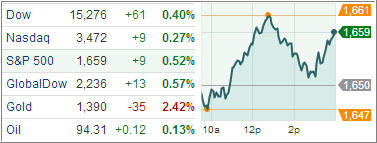Despite disappointing US industrial production and regional manufacturing reports, the major domestic equity markets were able to continue their recent rally and finish the trading session higher. The Dow Jones Industrial Average added 60 points (0.4%) to 15,276, the S&P 500 Index was 8 points (0.5%) higher at 1,659, setting another record in nine of the past 10 sessions, and the Nasdaq Composite gained 9 points (0.3%) to 3,472.
Stocks opened in the red as domestic and foreign economic data reminded investors of a cloudy growth picture. However, defensive sectors quickly overshadowed the early losses, and helped the broader market erase its early weakness.
Consumer staples and utilities outperformed as the two sectors settled with respective gains of 1.0% and 0.8%. The health care space lagged behind its defensively-geared counterparts as biotechnology became the subject of some profit taking following its recent run. Most other cyclical groups were somewhat shaky as the energy sector spent the day in negative territory. Crude oil was down as much as 2.0% before recovering those losses to end little changed at $94.30.
This morning’s economic data was plentiful as industrial production declined -0.5% in April, the most in eight months, and more than the consensus of -0.2%. The latest pullback supports expectations for a decline in activity this spring and summer in response to the fiscal cliff deal and the sequester.
Industrial production is tracking its historical performance at this stage of the business cycle. Manufacturing shrank a broad-based 0.4%, its third decline in the past four months. Core industrial production fell 0.3%, as four of its five components contracted. On a y/y basis, industrial production is up 1.9%, historically consistent with trend output growth. Core production has increased 1.0%, the slowest pace since February 2010.
Elsewhere, mortgage applications volume fell last week, as mortgage rates ticked up. The MBA Purchase Index slipped 4.1%, while refinance activity declined 8.1%, the most since January. Longer-term positive trends, however, remain intact.
In more bad news, the Eurozone reported disappointing 1Q GDP. The preliminary report showed a 0.2% quarter-over-quarter contraction, versus the 0.1% decline that economists had expected, but an improvement from the 0.6% drop posted in 4Q.
The lackluster GDP report was led by disappointing data out of the Eurozone’s largest economies as Germany’s growth of 0.1% q/q was below expectations, while the contraction for French output was larger than anticipated.
In the end, as I have repeatedly posted, bad news seems to be great news in regards to the direction of equities, which pushed our Domestic Trend Tracking Indexes (TTIs) deeper into bullish territory. The Domestic TTI has now reached a level of +5.05%, while the International TTI rallied to +10.41%.
Contact Ulli
